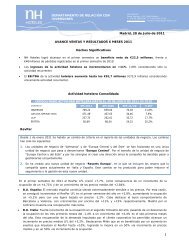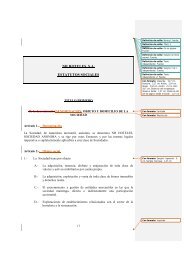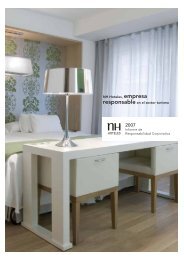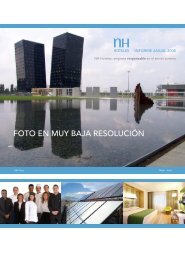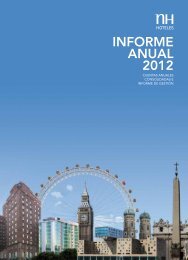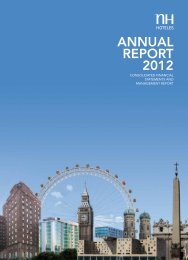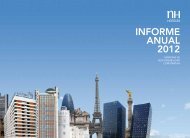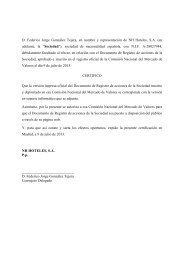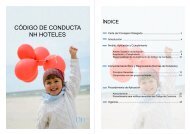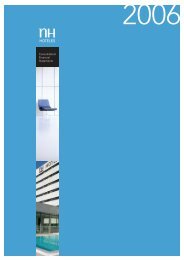Consolidated Financial Statements and Consolidated Management ...
Consolidated Financial Statements and Consolidated Management ...
Consolidated Financial Statements and Consolidated Management ...
You also want an ePaper? Increase the reach of your titles
YUMPU automatically turns print PDFs into web optimized ePapers that Google loves.
4.4. Intangible assets<br />
Intangible assets are considered to be any specifically identifiable non-monetary assets which have been acquired from third parties or developed by the<br />
Group. Only those whose cost can be estimated in an objective way <strong>and</strong> from which future economic profits are expected are recognised.<br />
Any assets deemed to contribute indefinitely to the generation of profits are considered to have an indefinite useful life. The remaining intangible assets<br />
are considered have a “specific useful life”.<br />
Intangible assets with an indefinite useful life are not depreciated <strong>and</strong> are hence subjected to the “impairment test” at least once a year (see Note 4.3).<br />
Intangible assets with a definite useful life are depreciated according to the straight-line method on the basis of the estimated years of useful life of the<br />
asset in question.<br />
The following are the main items recorded under the “Intangible assets” heading:<br />
i) Rights of use: This item reflects the right of operating Hotel NH Plaza de Armas in Seville acquired in 1994, whose depreciation has been caused by<br />
consolidated comprehensive profit/loss over the thirty years of the term of the agreement at a growing rate of 4% per year.<br />
ii) “Rental agreement premiums” reflect the amounts paid as a condition to obtain certain hotel lease agreements. They are depreciated on a straight-line<br />
basis depending on the term of the lease.<br />
iii) “Concessions, patents <strong>and</strong> trademarks” basically reflect the disbursements made by Gran Círculo de Madrid, S.A. for the refurbishment <strong>and</strong> remodelling<br />
works of the building where the Casino de Madrid is located. The depreciation of such works is calculated on a straight-line basis by taking into account<br />
the term of the concession for operating <strong>and</strong> managing the services provided in the building where the Casino de Madrid is located, which finalises on<br />
1 January 2037.<br />
iv) “Software applications” include different computer programs acquired by different consolidated companies. These programs are valued at their original<br />
cost price <strong>and</strong> depreciated at 25% per year on a straight-line basis.<br />
4.5. Impairment in the value of tangible <strong>and</strong> intangible assets excluding goodwill<br />
The Group assesses the possible existence of a loss of value each year that would oblige it to reduce the book values of its tangible <strong>and</strong> intangible assets.<br />
A loss is deemed to exist when the recoverable value is less than the book value.<br />
The recoverable amount is either the net sale value or the value in use, whichever is higher. The value in use is calculated on the basis of estimated future<br />
cash flows discounted at an after tax discount rate that reflects the current market valuation with respect to the cost of money <strong>and</strong> the specific risks<br />
associated with the asset.<br />
The discount rates used by NH Hoteles Group for these purposes range between 8.2% <strong>and</strong> 12%, depending on the different risks associated with each<br />
specific asset.<br />
If the recoverable amount of an asset is estimated to be lower than its book value, the latter is reduced to the recoverable amount by recognising the<br />
corresponding write-off using the consolidated comprehensive profit <strong>and</strong> loss statement.<br />
If an impairment loss is subsequently reversed, the book value of the asset is increased to the limit of the original value at which such asset was booked<br />
before the loss of value was recognised.<br />
Information on impairment losses detected in the financial year appears in Note 8 of this consolidated annual report.<br />
4.6. Leases<br />
The Group generally classifies all leases as operating leases. Only those leases which substantially transfer to the lessee the liabilities <strong>and</strong> advantages<br />
arising from the property <strong>and</strong> under the terms of which the lessee holds an acquisition option on the asset at the end of the agreement under conditions<br />
that could be clearly deemed as more advantageous than market conditions are classified as financial leases.<br />
4.6.1. Operating leases<br />
In operating lease transactions, ownership of the leased asset <strong>and</strong> substantially all the risks <strong>and</strong> advantages arising from the ownership of the asset<br />
remain with the lessor.<br />
When the Group acts as the lessor, it recognises the income from operating leases according to the straight-line method in keeping with the terms<br />
of the agreements entered into. These assets are depreciated in accordance with the policies adopted for similar own use tangible assets. When the<br />
Group acts as the lessee, lease expenses are charged to the consolidated comprehensive profit <strong>and</strong> loss statement on a straight-line basis.<br />
4.6.2. <strong>Financial</strong> leases<br />
The Group recognises financial leases as assets <strong>and</strong> liabilities in the consolidated balance sheet at the start of lease term at the market value of the<br />
leased asset or at the actual value of the minimum lease instalments, should the latter be lower. The interest rate established in the agreement is used<br />
to calculate the actual value of the lease instalments.<br />
The cost of assets acquired through financial leasing agreements is booked in the consolidated balance sheet according to the nature of the asset<br />
described in the agreement.<br />
The financial expenses are distributed over the period of the lease in accordance with a financial criterion.<br />
4.7. <strong>Financial</strong> instruments<br />
4.7.1 <strong>Financial</strong> assets<br />
<strong>Financial</strong> assets are recognised in the consolidated balance sheet when they are acquired <strong>and</strong> initially booked at their fair value. The financial assets<br />
held by Group companies are classified as follows:<br />
- Marketable financial assets: These include any assets acquired by the companies with the aim of taking short-term advantage of any changes their<br />
prices may undergo or any existing differences between their purchase <strong>and</strong> sale price. This item also includes any financial derivatives that are not<br />
considered accounting hedges.<br />
- <strong>Financial</strong> assets at maturity: These are assets subject to a fixed or determinable redemption amount which mature over time. The Group declares its<br />
intention <strong>and</strong> its capacity to keep these in its power from the date of acquisition to their maturity date.<br />
72<br />
REPORT ON THE CONSOLIDATED FINANCIAL STATEMENTS



